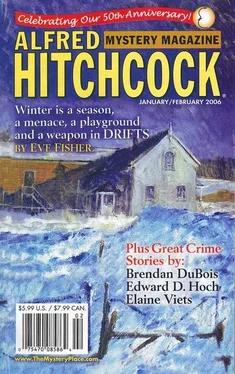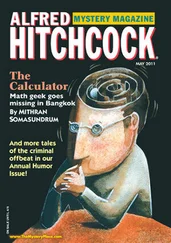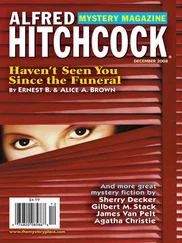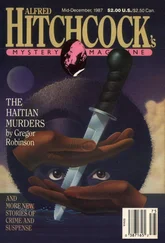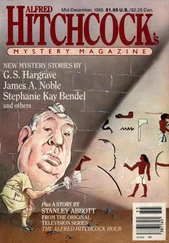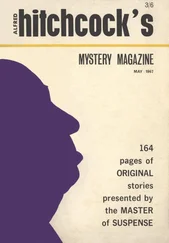John Betancourt - Alfred Hitchcock’s Mystery Magazine. Vol. 51, No. 1 & 2, January/February 2006
Здесь есть возможность читать онлайн «John Betancourt - Alfred Hitchcock’s Mystery Magazine. Vol. 51, No. 1 & 2, January/February 2006» весь текст электронной книги совершенно бесплатно (целиком полную версию без сокращений). В некоторых случаях можно слушать аудио, скачать через торрент в формате fb2 и присутствует краткое содержание. Город: New York, Год выпуска: 2006, Издательство: Dell Magazines/Crosstown Publications, Жанр: Детектив, на английском языке. Описание произведения, (предисловие) а так же отзывы посетителей доступны на портале библиотеки ЛибКат.
- Название:Alfred Hitchcock’s Mystery Magazine. Vol. 51, No. 1 & 2, January/February 2006
- Автор:
- Издательство:Dell Magazines/Crosstown Publications
- Жанр:
- Год:2006
- Город:New York
- ISBN:нет данных
- Рейтинг книги:4 / 5. Голосов: 1
-
Избранное:Добавить в избранное
- Отзывы:
-
Ваша оценка:
- 80
- 1
- 2
- 3
- 4
- 5
Alfred Hitchcock’s Mystery Magazine. Vol. 51, No. 1 & 2, January/February 2006: краткое содержание, описание и аннотация
Предлагаем к чтению аннотацию, описание, краткое содержание или предисловие (зависит от того, что написал сам автор книги «Alfred Hitchcock’s Mystery Magazine. Vol. 51, No. 1 & 2, January/February 2006»). Если вы не нашли необходимую информацию о книге — напишите в комментариях, мы постараемся отыскать её.
Alfred Hitchcock’s Mystery Magazine. Vol. 51, No. 1 & 2, January/February 2006 — читать онлайн бесплатно полную книгу (весь текст) целиком
Ниже представлен текст книги, разбитый по страницам. Система сохранения места последней прочитанной страницы, позволяет с удобством читать онлайн бесплатно книгу «Alfred Hitchcock’s Mystery Magazine. Vol. 51, No. 1 & 2, January/February 2006», без необходимости каждый раз заново искать на чём Вы остановились. Поставьте закладку, и сможете в любой момент перейти на страницу, на которой закончили чтение.
Интервал:
Закладка:
A black iron fence enclosed the entire lot except for the driveway. An old-fashioned mailbox was mounted on the fence next to the gate at the sidewalk in front of the house. Even at this distance Auburn could read the name Blanford stenciled on it.
“Anybody home over there?”
“Nobody came to the door,” said Krasnoy. “The man from the bar, Casteven, says she lived alone.”
Auburn glanced at the handbag lying on the plastic sheet. “Any confirmation of her ID?”
“Couple credit cards in the name of Ida Blanford. No cash in the handbag, just a bunch of keys and some personal stuff. DMV says she didn’t have a current driver’s license because of substandard vision.”
Kestrel, having taken several photographs for orientation, passed the handbag to Auburn and removed the sheet from the body. A murmur of ghoulish satisfaction went up from the growing crowd.
The dead woman lay spread-eagled on her back, with her head about a foot and a half from the water. Her eyes were half open, her refined features set in a sallow mask, her bobbed white hair disheveled. She wore no jewelry. Her floral print blouse clearly showed a blood-ringed hole just left of center in the chest. There were smears of mud on her light blue slacks but none on the soles of her shoes.
While Kestrel went on taking pictures, Auburn examined the contents of the handbag — a hairbrush, a handkerchief, a ring of nine keys, a pair of thick trifocals in a crushproof case, a package of chewing gum. A compact billfold contained two credit cards, a Social Security card, and a senior citizen’s discount card, but no money and no further identification.
“Rigor is pretty well advanced,” Kestrel said, now squatting beside the body. “It would have been cool down here by the water last night, but even so, I’d say she must have been dead since midnight.”
“Somebody should have heard a shot,” said Auburn.
“The guy at the bar and grill didn’t,” said Dollinger. “He lives upstairs over there. We didn’t ask anybody else yet, but that’s right up top on our agenda.”
“One wonders,” said Krasnoy, “why they didn’t just throw her and her bag in the river.”
“They may have tried, and missed the water in the dark,” said Dollinger. To Auburn, he added, “They must have tossed her from up here on the grass. Terry and I made those footprints when we covered her up, and they’re the only ones near the body.”
“Any bloodstains or other traces around here on the grass, or over on the sidewalk?”
“No blood that we could see,” said Krasnoy, “and no shell. Here comes our ancient mariner,” he added under his breath.
Auburn turned to see a stocky middle-aged man stepping with pompous self-assurance over the yellow tape and descending the bank. With his floppy-brimmed hat adorned with fishing flies and his sunburnt nose, he looked like something straight out of a beer commercial on TV. When he got closer, Auburn sensed that he had indeed just had a beer, if not two, at the establishment across the street.
His name was Fred Shannoy; he was on a two week vacation from his job with an advertising agency. “I’m not what you’d call a serious fisherman,” Shannoy assured him. “Anything I catch I throw back. I figure it’s going to be full of lead or mercury or radioactive wastes anyway... Hey, I don’t even like fish.”
Auburn obliged him with the expected chuckle. “Do you own the boat, Mr. Shannoy?”
“Rented. I showed the papers to the officers here.”
“Where did you cast off this morning?”
“The landing at the park up in Stillwell, around seven. Told them that too. I was just drifting with the current, looking for a shady spot to tie up, when I saw this old gal lying here on the bank. Kind of like a sunbather, you know? Except she was in the shade and she had all her clothes on. And then when I got close enough, I saw she was... uh... well, you know. Not with us any more.”
Just the sort of circumlocution, thought Auburn, that one might expect from an advertising man.
“So I pulled in and tied up downstream there and came ashore.” He glanced briefly at his muddy shoes. “The place across the street, The Green Fish, wasn’t open for business yet, but there was a truck there delivering meat, so I went in and called you guys. That... that’s a bullet hole, isn’t it?”
“That’s what it looks like. Are you familiar with this area?”
“No, sir. Never been here before, either by land or by sea.”
“Did you see anybody here on the bank besides the dead woman?”
“No. Not on this side of the river, anyway. I saw a few joggers and pedestrians over on the downtown side.”
Auburn was making a final check of Shannoy’s written statement when Nick Stamaty from the coroner’s office arrived. Dark and heavily built, Stamaty dressed like a college president, moved with the grace of a sumo wrestler, and radiated the sincerity of a Sunday-school teacher.
“Straighten your ties, guys,” he said, before even looking at the remains of Ida Blanford. “The camcorders are coming.”
Auburn stepped up to the brow of the levee and peered down into the street. “It’s Channel Four,” he reported to the others. “They usually behave pretty well.”
After sending Shannoy off to resume his fishing, Auburn filled Stamaty in on the details thus far known. Stamaty unslung his camera case and checked the position of the sun. “Let me get some pictures. Then we’ll see if one of those keys gets us in the house.”
While waiting for Stamaty to finish his work around the body, Auburn walked west along the top of the levee, away from where the TV crew were setting up, and surveyed the scene from a distance. A quarter of a mile downstream stood a massive steel-truss railroad bridge, no longer in use.
The broad, shallow river had never supported much traffic, but since the rebuilding of the dam at Tippettsville in the 1960’s to prevent spring flooding, it amounted to little more than a stream. A hulking wharf and warehouse, part wood and part brick, stood at the water’s edge just this side of the railroad bridge. A row of cars parked outside the warehouse indicated that it was still being put to some use.
Stamaty was adding the final touches to a sketch on a clipboard when he caught up with Auburn. His left little finger was hooked through Ida Blanford’s big ring of keys. “Looks like point-blank range to me, Cy,” he said.
The crumbling sidewalk in front of the house had been marked long ago for repairs with red spray paint and then apparently forgotten. The mailbox was empty. The hinges on the gate needed oil. But the tree-shaded lawn was neatly trimmed and free of weeds. They waited a full minute after Auburn manipulated the knocker on the front door before starting to try keys in the lock.
The house was dark, quiet, and cool. Not a trace of disorder or a speck of dust spoiled the old-fashioned but opulent decor, as if Ida Blanford had known, the last time she left, that she would never return. Auburn recalled that she’d been a schoolteacher. From the entry hall they passed into a parlor that looked like a principal’s office, a kitchen like a high school physics lab, and a dining room as bare as the refectory of a convent. Every light they turned on in the parlor blazed with maximum wattage. A reading glass rested on the desk, another next to the chair in the front window.
Further exploration revealed a pantry, another parlor, and an enclosed back porch facing the river. The rear parlor was somewhat more habitable than the front one, with shelves of old books, family photographs in silver frames, more bright lights, and more magnifying glasses. Every window on the ground floor was closed and latched. Deadbolts were shot on side and back doors.
Читать дальшеИнтервал:
Закладка:
Похожие книги на «Alfred Hitchcock’s Mystery Magazine. Vol. 51, No. 1 & 2, January/February 2006»
Представляем Вашему вниманию похожие книги на «Alfred Hitchcock’s Mystery Magazine. Vol. 51, No. 1 & 2, January/February 2006» списком для выбора. Мы отобрали схожую по названию и смыслу литературу в надежде предоставить читателям больше вариантов отыскать новые, интересные, ещё непрочитанные произведения.
Обсуждение, отзывы о книге «Alfred Hitchcock’s Mystery Magazine. Vol. 51, No. 1 & 2, January/February 2006» и просто собственные мнения читателей. Оставьте ваши комментарии, напишите, что Вы думаете о произведении, его смысле или главных героях. Укажите что конкретно понравилось, а что нет, и почему Вы так считаете.
